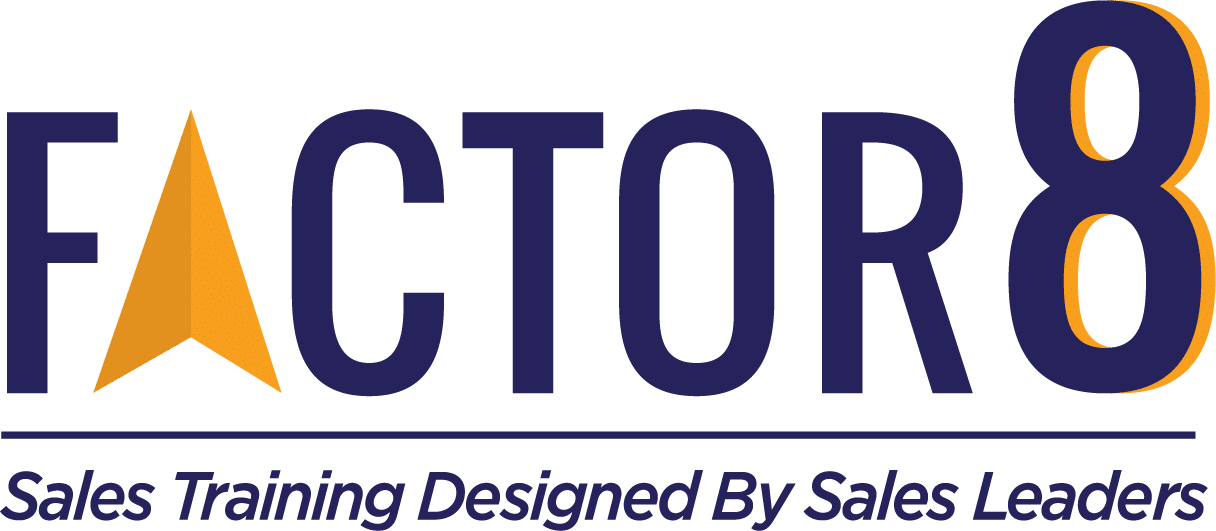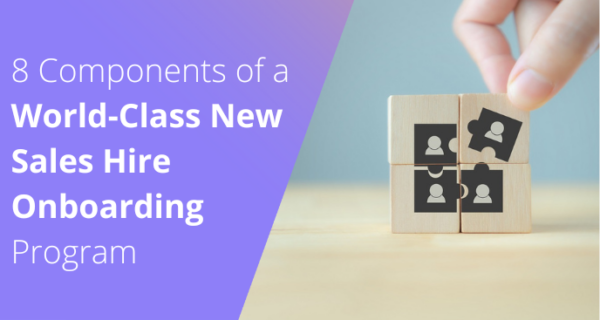8 Components of a World-Class New Sales Hire Onboarding Program
Been thinking that revenue targets would be easier to crush if your new hires would ramp up to speed more quickly? You’re spot-on, my friend.
WATCH: Onboarding Sales Reps: 10 Hacks To Improve Training + Ramp Time
Best-in-class onboarding (or new hire training) programs go well beyond the standard “Welcome to the company” orientation and dive into actual job training. But most programs stop after introducing reps to their new systems and products. This leaves reps on their own to figure out things like:
- What do I do first?
- How do I get people to call me back?
- What do I say if they ask me X?
The result? Long ramp times, while they use experience to supplement what they could have been taught.
There will always be a ramp period. Our goal is to shorten it. Awesome new hire programs have been proven to cut new hire ramp-to-target in half (Training Magazine).
What is the right ramp time? Sorry for this, but it depends – on the talent you’re hiring, your training program, and the complexity of your offering and sales cycle. But here are a few basic benchmarks:
- Top business development (BDR, SDR) programs ramp reps before three months.
- Account managers between three and six months.
- If your deals aren’t over $200K, your sales cycle is over 6 months, and it’s taking your reps 6+ months to hit quota, your program probably needs some help.
I’ve been building and benchmarking new hire programs for the past fifteen years, and there are very few who don’t need help. Why?

Most onboarding programs need help because trainers don’t get sales, and sellers don’t usually get training – it’s a sandbox thing.
A great program is a killer combination of both worlds. Incidentally, a great program can also shrink your rep attrition. Keep them longer, ramp them faster = this is worth your investment, sales leaders!
READ: How to Hire and Retain Top Sales Reps and Managers
Here are eight signs of a world-class rep onboarding program (that you should steal immediately!)
1. Training is a process, not an event.
Think of it as “Just-in-time training.” 100% classroom time is 1-2 weeks and then decreases gradually to once a month.
For example, a new hire is in full-time training for 2 weeks, but by week 4 they’re in class 2 hours a day, and in week six 1 hour a day. By week 8 it’s one hour a week and by month three (and for the rest of their tenure!) they’re in training once a month.
This makes it critical to focus their first two weeks only on what they’ll need in month one on the phone. Why? They’ll have no idea what they don’t know yet. That means you’ll graduate a team of super-confident sellers who can’t wait to get on the phones. Perfect.
2. Use call recordings.
This is my favorite tip. My theory on ramp time is that it will always be present because it isn’t the “what to do/say” that takes a long time to get. It’s the “when do I do it/say it” that takes experience to really nail. So shorten that by letting reps listen to call recordings. Nope, the recordings don’t have to be their own, and they shouldn’t all be great calls. Just typical. It’s like reviewing game tapes before the big game – breaking down what the other team (customer) is doing and when they should have used the right play (skill).
3. Includes 6 critical components
All six critical components of the program are included and mixed together:
1. Systems & Tools – CRM, Intranet, Lead Management, AI, etc.
2. Product/Service – be sure it’s “how to sell it” and not “the full history of it”
3. Sales – how to sell our products over the phone (not generic sales 101 field training!)
4. Process – how leads and orders get processed + rep and customers’ top 10 questions
5. Acumen – business acumen, industry acumen, and customer acumen – critical!
6. Manager integration – nope, lunch on day one isn’t enough. Get them more involved.
4. GET ON THE PHONES! (ASAP).
If you can create an exercise where reps are calling current, potential, or even past customers by day two, do it! They can qualify leads, gather success stories, call cold leads – whatever! The right hires are itching to start calling, and the wrong hires will show reluctance and wash out. You’re welcome.
READ: Tips for Virtually Onboarding New Sales Reps
5. Less than 30% is e-learning.
Sorry large organizations, I know it’s so tempting! But classroom-based training (in-person or virtual) is still the most effective for a reason: You can’t practice selling with a computer! Also, how engaging is your new hire’s experience when they’re clicking forward 200 times a day? Painful.
6. Rigor.
In my experience, a good 25% of every new hire class should not graduate training (yes, please be sure you’re hiring in groups, not “onesie-twosie”). When you really trust your training department, you’ll count on them to de-facto manage reps during training and coach them out the door if they won’t make it. Start, stop, and break times should be like real life on the floor, and weekly tests let them know how they’re doing.
7. Training mimics the floor.
Quick hit ways to do this:
a. You have a systems sandbox for training (a monthly updated mirror image of all systems)
b. Phones and systems in the classroom for better role plays
c. Dummy accounts or even real (low scoring) accounts for practice
d. Call coaching or quality forms approved by sales leadership used for role plays/testing
e. Scenario-based testing (because when is a real client going to say, “A. send me a quote…B. schedule a call back…”?)
8. Don’t let HR teach reps how to sell.
There’s a difference between regular company training and sales training. Aberdeen recently reported that 85% of best-in-class sales teams use a professional sales curriculum or trainer. What is good sales training? (read more about that here)
Overwhelmed? Here are a few easy ways to start:
- Get to know your training ASAP. Pick your best sales leader and charge them with shortening ramp. Attend training, learn about good training, and partner and assist your trainer with the curriculum.
- Get the reports. Sales numbers won’t show you class-by-class ramp times unless you specifically build them. Believe me, it’s worth it.
- Close the loop. Are you reporting the top three skill gaps on the floor to training on a monthly or quarterly basis? Do you have the call coaching and rep meeting cadence in place to provide this?
- Get some help. Spend the money to bring in a professional sales training leader, someone to fix your program or a great sales training curriculum. When reps ramp faster and stay longer, you’ll wish you budgeted for this three years ago!

